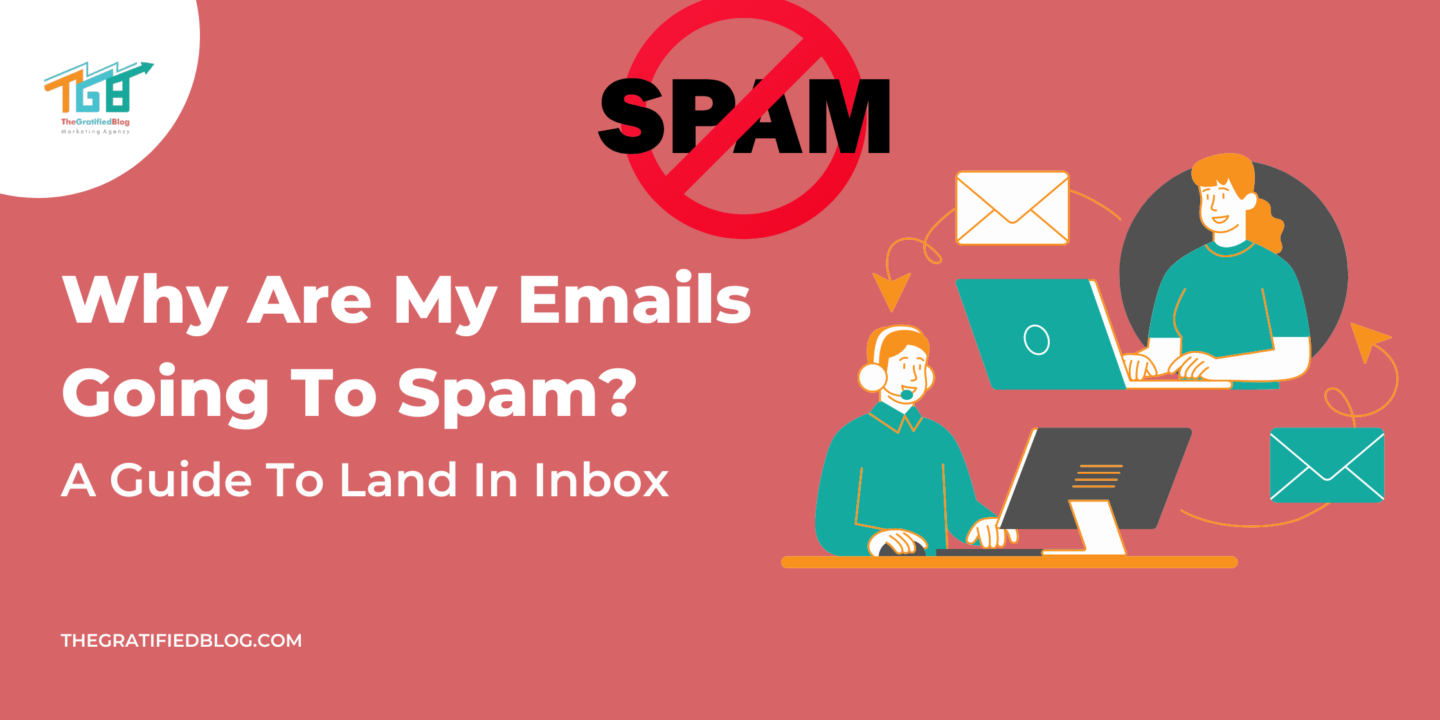
“Why Are My Emails Going to Spam?” – This question leaves email senders frustrated and perplexed, wondering why their carefully crafted messages are being banished to the dark abyss of the spam folder. In today’s email marketing world, where email communication plays a vital role in personal and business interactions, understanding the reasons behind this predicament is crucial.
This blog delves into various aspects related to email deliverability, including the definition of the email spam folder, understanding the factors that influence email deliverability, common reasons behind emails ending up in the spam folder, best practices to enhance email deliverability, and answers to frequently asked questions.
By exploring these topics, readers will gain valuable insights into optimizing their email campaigns and improving their chances of reaching recipients’ inboxes.
So, let’s begin!
Definition Of Email Spam Folder

The spam folder, or the junk folder, is a designated folder within an email client or service that filters and segregates incoming emails considered unsolicited or unwanted by the recipient. It is a protective measure to prevent users from being overwhelmed by irrelevant or potentially harmful messages.
Exploring Factors Affecting Email Deliverability And Causes Of Emails Going To Spam
Email deliverability pertains to the capacity of an email to reach its intended destination in the recipient’s inbox successfully. It is influenced by various technical and behavioral factors that determine whether an email is classified as legitimate or spam. Email deliverability relies not solely on the sender’s actions but is also influenced by the recipient’s email provider and filtering systems.
Factors Affecting Email Deliverability
- Sender reputation: It plays a crucial role in email deliverability. Email service providers assess the sender’s reputation, such as sending practices, complaint rates, and bounce rates. A positive sender reputation indicates trustworthiness and can improve the chances of emails reaching the inbox.
- Content quality: The content of an email significantly impacts its deliverability. Emails with relevant, valuable, and engaging content are more likely to be well-received by recipients and email providers. Avoiding spam trigger words, excessive use of capital letters, and misleading claims helps maintain a positive reputation and deliverability.
- Authentication and SPF records: Proper email authentication is essential for good deliverability. Implementing authentication protocols like Sender Policy Framework (SPF), DomainKeys Identified Mail (DKIM), and Domain-based Message Authentication, Reporting, and Conformance (DMARC) verifies the legitimacy of the sender, reducing the chances of emails being marked as spam.
- List hygiene: Keeping your email list pristine for deliverability is vital. Regularly removing invalid, outdated, or inactive email addresses helps minimize bounce rates and enhances the sender’s reputation. Maintaining a healthy list ensures that emails are sent to engaged recipients who are more likely to interact with the content.
- Engagement rates: It measure how recipients interact with emails, such as opening, clicking, or replying. Email providers consider engagement as an indicator of content relevance and sender reputation. Higher engagement rates positively impact deliverability, while low engagement rates may result in emails being flagged as spam. Encouraging recipients to engage with emails through personalized content and compelling calls to action can improve overall deliverability.
Common Reasons Why Are My Emails Going To Spam
- Poor Subject Lines: Subject lines that are vague, misleading, or overly promotional can trigger spam filters. It’s important to craft subject lines that accurately represent the content of the email and avoid using excessive capitalization or misleading language.
- Excessive Use of Spam Keywords: Spam filters are designed to flag emails that contain specific keywords commonly associated with spam. Using a disproportionate number of these keywords, such as “free,” “discount,” or “guaranteed,” heightens the risk of your email being flagged as spam.
- Misleading or Deceptive Content: Emails that contain misleading or deceptive content, such as false claims, exaggerated promises, or fraudulent offers, are likely to be detected by spam filters. Providing clear, honest, and transparent information in your email content is crucial.
- Missing or Inaccurate Authentication: Email authentication protocols, like SPF, DKIM, and DMARC, help verify the sender’s authenticity and ensure that the email has not been tampered with during transmission. Spam filters may flag emails as suspicious if they lack proper authentication or have incorrect authentication records.
- Sending to Unengaged or Inactive Recipients: Email providers consider recipient engagement an essential factor in determining the legitimacy and relevance of emails. Sending emails to recipients with little to no engagement, such as not opening or interacting with previous emails, can increase the likelihood of your future emails being filtered as spam.
Why Are My Emails Going To Spam: Best Practices To Improve Email Deliverability

Poor Domain And Sending IP Reputation
Having a bad reputation for your domain and sending IP can significantly impact your email deliverability. Email service providers track the sending history and reputation of domains and IPs to determine the legitimacy and trustworthiness of email senders. If your domain or sending IP has been associated with spamming activities in the past, email providers may classify your emails as suspicious or spam and filter them accordingly.
For example, if spammers have previously used their sending IP to send unsolicited emails or engage in malicious activities, it can be blocked or flagged by email providers. As a result, legitimate emails from your domain may be mistakenly filtered as spam or blocked, preventing them from reaching the recipients’ inboxes.
You can take several actions to improve your domain and send IP reputation. These include implementing proper email authentication protocols like SPF, DKIM, and DMARC to verify your identity and ensure your emails are not forged or spoofed.
Your Recipients Marked Your Emails As Spam
One factor that can negatively impact email deliverability is when recipients mark your emails as spam. When recipients consistently label your emails as spam, it signals to email service providers that your messages are unwanted or unsolicited. This can lead to your emails being filtered or blocked in the future. Here’s an example to illustrate this scenario:
Let’s say you have sent promotional emails to recipients who did not explicitly permit you to contact them. Over time, some recipients may find your emails irrelevant or intrusive, causing them to mark your emails as spam. As a result, email service providers notice the increasing number of spam complaints associated with your sender address or domain. Subsequently, they may begin filtering your emails to recipients’ spam folders or even block them altogether, hindering your email deliverability.
To avoid this situation, obtaining permission from recipients before sending them emails is crucial. Implementing proper opt-in procedures, double opt-in methods, and respecting unsubscribe requests can help build a positive reputation and prevent recipients from marking your emails as spam.
You’re Using Sloppy HTML
Sloppy HTML refers to poorly structured or formatted HTML code in your email content. It can include missing or mismatched tags, incorrect or inconsistent coding practices, or excessive use of deprecated HTML elements. Sloppy HTML can negatively impact email deliverability and rendering across different email clients.
For example, suppose your email contains broken image links, improperly formatted tables, or excessive inline CSS. In that case, it may result in rendering issues or trigger spam filters, leading to lower deliverability rates.
To avoid this problem, it is crucial to adhere to HTML best practices, use a responsive email template, validate your HTML code, and test your emails across different email clients and devices, ensuring clean and well-structured HTML can improve email deliverability and provide a better user experience for your recipients.
Your Content Contains Spam Triggers
Spam filters are designed to identify specific patterns, keywords, or phrases commonly associated with spam. If your email content includes such spam triggers, it can increase the likelihood of your emails being flagged as spam.
For example, excessive exclamation marks, phrases like “act now,” or misleading claims can trigger spam filters.
To improve deliverability, it’s essential to craft your content carefully, avoiding spam-triggering elements and focusing on providing valuable and relevant information to your recipients. Regularly reviewing your email content and running it through spam checkers can help identify and address potential triggers.
Ensure Proper Email Formatting And Practices
Have a Working Reply-to Address: A functional reply-to address allows recipients to respond to your emails quickly and directly communicate with you. This improves the user experience and enhances the legitimacy and credibility of your emails.
Example: Reply-to: contact@yourcompany.com
Avoid Link Shorteners: While link shorteners can be convenient for sharing long URLs, they can raise suspicion and trigger spam filters. Using complete and reliable URLs in your emails helps establish transparency and builds trust with recipients and email providers.
Example: Instead of www.shorturl.co/abc123
Use: www.yourwebsite.com/blog/article-title
Use Reliable and Verified URLs: Ensure that the URLs included in your emails are from reputable sources and verified to be safe and secure. Suspicious or unverified URLs may raise red flags for spam filters and recipients.
Example: Instead of: www.randomwebsite.com/g7jFds
Use: www.trustedwebsite.com/safe-page
You Don’t Include An Unsubscribe Link
Incorporating an unsubscribe link is essential in every email you send. Failing to provide recipients with a straightforward way to opt out of receiving your emails can negatively affect your email deliverability. With an unsubscribe option, recipients may avoid marking your emails as spam, leading to increased complaints and a potential decline in your sender’s reputation.
Including an unsubscribe link demonstrates respect for recipients’ preferences and contributes to sustaining an active and engaged subscriber base. List. Moreover, it complies with regulations such as the CAN-SPAM Act, which requires commercial emails to provide a visible and functional unsubscribe mechanism.
Here’s an example of how you can include an unsubscribe link in your email footer:
“Unsubscribe | Update Preferences” By clicking the “Unsubscribe” link above, you will no longer receive emails from us. To update your email preferences, click “Update Preferences.”
You’re Sending Too Many Suspicious Attachments
Sending a high volume of attachments or attachments that trigger suspicion can raise red flags for spam filters and recipient email providers. Excessive attachments can increase the file size of your emails, leading to potential delivery issues or even getting flagged as spam.
Example: Suppose you’re running an e-commerce business and frequently send customer order confirmations. Instead of attaching detailed invoices or receipts as large attachments, providing secure download links within the email is advisable. This reduces the email file size and avoids triggering suspicion from spam filters.
Following this best practice improves the chances of your emails reaching the inbox rather than being flagged as spam or blocked due to excessive or suspicious attachments.
You Don’t Have Permission From Your Recipients
Obtaining permission from recipients is crucial for maintaining a healthy email list and improving deliverability. You risk being reported as spam when you send emails to individuals who haven’t explicitly given consent or opted-in to receive your communications. This can harm your sender’s reputation and impact your overall deliverability rates.
Example: Let’s say you operate an online store selling fitness products. Instead of sending promotional emails to a purchased email list, you should build your opt-in subscriber base.
By implementing strategies like using sign-up forms on your website or offering incentives for newsletter subscriptions, you ensure that recipients have willingly provided their email addresses and granted permission to receive them. This approach fosters a better relationship, enhances your connection with subscribers, and increases the likelihood of your emails being well-received and engaged.
Pro Tip: Tools And Resources For Email Deliverability
Email Deliverability Monitoring Tools: Email deliverability monitoring tools provide valuable insights into the performance of your email campaigns, including crucial metrics like delivery rates, bounce rates, and spam placement. These tools allow you to observe and analyze your email deliverability metrics, providing actionable data to identify issues and make necessary improvements. Examples of such tools include EmailAnalytics, Microsoft Viva, Yesware, and many others.
Email Service Provider (ESP): Various email service providers, including HubSpot, Mailchimp, Salesforce, and others, not only offer email delivery services but also provide valuable resources, guidelines, and best practices to improve email deliverability. These providers recommend implementing authentication protocols, optimizing email content, and managing email lists effectively to enhance your deliverability rates.
FAQ’s
Q1. Can A Single Email Trigger A Spam Filter?
A. Yes, even a single element of spammy content, such as excessive exclamation points or a suspicious link, can trigger a spam filter and result in the email being marked as spam.
Q2. Is It Necessary To Segment Email Lists For Better Deliverability Rates?
A: Yes, segmenting email lists is crucial for enhancing deliverability rates as it allows you to send tailored and targeted messages to specific groups of subscribers. Segmenting your email lists ensures that the content you send aligns with the interests and preferences of each segment.
Q: What Is The Impact Of Emails Going To Spam On The Overall Email Campaign Success?
A: Emails that end up in the spam folder significantly reduce the success of an email campaign by decreasing the open rates, click-through rates, and overall engagement.
Conclusion
Now that you better understand why your emails may be going to spam, take corrective measures and enhance your engagement rates.Suppose you face any difficulties in resolving them. Then, feel free to leave your questions in the comment section. We will be happy to answer you.
Thanks for reading 🙂








No Comments